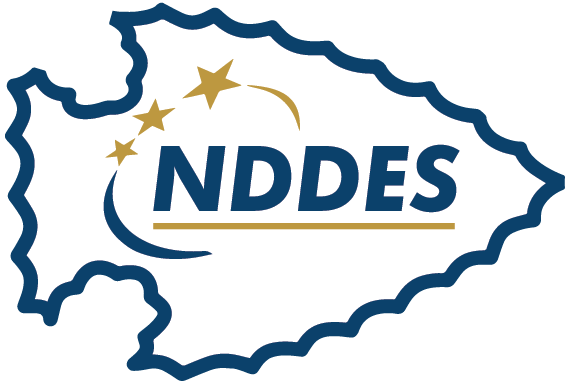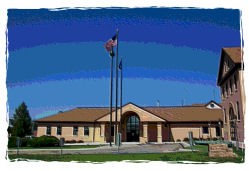
Our Vision: A safe, secure and resilient North Dakota.
Our Mission: Providing North Dakota with a central coordinating agency for public safety communications, prevention, protection, mitigation, response and recovery.
Our Values:
- Integrity - our words match our actions; we will strive to do what is right.
- Respect - we will treat others as we want to be treated.
- Excellence - we will perform professionally to the best of our ability.
History
 The genesis of the emergency management component of North Dakota Department of Emergency Services (NDDES) can be traced to the Civil Defense Act of 1951. The statewide communications function was also established during the 1951 Legislative Session, and State Radio became operational in 1952 at the Bismarck Airport. By 1968, State Radio was located at what is now Building 35 at Fraine Barracks.
The genesis of the emergency management component of North Dakota Department of Emergency Services (NDDES) can be traced to the Civil Defense Act of 1951. The statewide communications function was also established during the 1951 Legislative Session, and State Radio became operational in 1952 at the Bismarck Airport. By 1968, State Radio was located at what is now Building 35 at Fraine Barracks.
The Division of Emergency Management and State Radio Communications were combined in 2003 to establish an integrated State Operations Center. Two years later, action during the 59th Legislative Assembly created NDDES comprised of the Division of Homeland Security and State Radio Communications.
Culminating in 1979 with the creation of the Federal Emergency Management Agency (FEMA), the emphasis changed from nuclear preparedness to coordinating natural disaster preparedness, mitigation, response, and recovery activities. In addition to its disaster and statewide emergency communications roles, the department maintains homeland security responsibilities. It operates in a dynamic environment that encompasses an increasing number of natural disasters, prevention activities to deal with continuously evolving security threats, and the ever-present need to improve state infrastructure to provide interoperable communications resulting in efficient and reliable public safety services. Its mission is to conduct planning, coordination, communications, and operations for the safety and security of all North Dakota citizens.
In 2025, the divisions were renamed to Homeland Security and Emergency Management and the State Emergency Communications Center to more accurately reflect the work and technology used. This was signed into law under House Bill 1079.
Structure
The Adjutant General, Brig. Gen. Mitchell Johnson, serves as Director of the Department of Emergency Services and appoints the Directors of Homeland Security and Emergency Management and State Emergency Communications Center.
What We Do
The department provides 24/7 emergency communications and resource coordination with more than 50 lead and support agencies, private enterprise, and voluntary organizations to assist local jurisdictions in disaster and emergency response activities. It administers federal disaster recovery programs and the Homeland Security Grant Program. NDDES also manages the Emergency Management Assistance Compact (EMAC) that serves as a national clearinghouse through which member states may request and provide mutual aid assistance.
Local and tribal governments maintain direct responsibility for initial response to incidents, emergencies, disasters, or catastrophes. Local emergency managers serve a key role in coordinating response and recovery efforts by providing situational awareness and accompanying resource requirements. NDDES supports response and recovery coordination with emergency managers in each county and tribal nation within the state of North Dakota as well as the cities of Bismarck and Fargo.
The State Radio Communications System has over four thousand users representing two hundred and eighty-seven agencies of the local, state, and the federal government. The Division of State Radio coordinates 9-1-1 services as well as emergency medical, fire, and law enforcement response for twenty-five North Dakota counties and is the designated back-up for eight of the other public service answering points throughout the state, serving as a secondary backup for an additional eight. State Radio is the primary dispatch center for N.D. Highway Patrol, Game and Fish, various other state and federal agencies, and also respond to calls for emergency assistance across the state. Statewide communication services ensure necessary resources are dispatched for emergency response.
Committees and Boards
DESAC
The Adjutant General also serves as the Chairman of the Department of Emergency Services Advisory Committee (DESAC) charged to provide direction and guidance in policy formation. Its members represent major customer and stakeholder constituencies that include local and state law enforcement, public health, emergency medical services, city and county government, local fire services, local emergency management, private enterprise, information technology and statewide 9-1-1 services.
SLIC
NDDES has significant representation in the State and Local Intelligence Center (SLIC), which serves as the state’s designated fusion center. The SLIC’s mission is to gather, store, analyze and disseminate information on crimes, both real and suspected, to the law enforcement community, government officials and private industry concerning dangerous drugs, fraud, organized crime, terrorism and other criminal activity for the purposes of decision making, public safety and proactive law enforcement while ensuring the rights and privacy of citizens. The SLIC is multi-agency and is comprised of staff from NDDES, NDBCI, NDHP, NDNG, and NDIT.
SERC
The State Emergency Response Commission is a multi-agency endeavor whose responsibility is to coordinate the state hazardous chemicals preparedness and response program in conjunction with local emergency planning committees and organizations.
